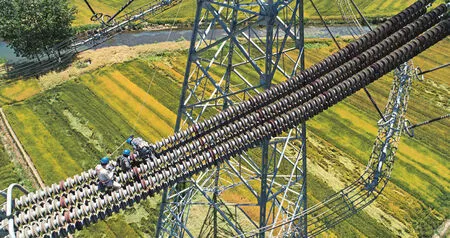Ultra-High Voltage System Supercharges Energy Revolution
By SHANG QIANMING
IN January 2009, the 1,000 kV ultra-high voltage(UHV) alternating-current (AC) power transmission line from southeastern Shanxi Province to Jingmen in Hubei Province began operation.During their meeting in the U.S. a few months later,Steven Chu, the United States Secretary of Energy at the time, told then State Grid Corporation of China(State Grid) Chairman Liu Zhenya that he envied China’s UHV project, admitting that China was ahead of the U.S. in this area and expressing his wish to share China’s relevant achievements.
From high voltage to extra-high voltage and finally ultra-high voltage transmission, moving up the voltage chain in power transmission is a tremendous technological challenge. Compared with that of lower voltage, UHV (1,000 kV for alternating current and±800 kV for direct current or above) transmission can run over a longer distance, is of a higher capacity and lower losses, and saves land resources. The inauguration of China’s first UHV project on January 6, 2009,marks the country’s leading position in power transmission technology worldwide.
UHV technology solves the problem of transregional power transmission over a long distance, and creates the conditions for extensive development of renewable energy resources - wind, solar, and hydro power - in western China. It is therefore critical for China’s energy revolution and development of advanced productive forces in the country.

The maintenance personnel of Jiangsu power transmission and distribution are working on the ±800 kV DC transmission line in Taizhou City of Jiangsu Province on May 29, 2020.
Leading the World in Power Technology
China started research on UHV technology in 1986, and made it a key subject in scienti fic and technological programs in the Seventh, Eighth and 10th Five-Year Plan periods (1986-1990, 1991-1995,and 2001-2005 respectively). Development of UHV AD transmission technology was later included in the Outline of the National Program for Long- and Medium-Term Scienti fic and Technological Development and the National Science and Technology Support Program. The completion of the 750 kV power distribution and transmission project in northwestern China in 2005, which employed domestic technologies, and the success of ±500 DC transmission from the Three Gorges Dam to other parts of China, are both testimony of marked improvements in China’s capacity in designing and manufacturing power distribution and transmission equipment. This progress laid the groundwork for the development and deployment of UHV technology and equipment in China.
Despite headways made in the field over a 20-year period, there were still many thorny technical issues to be solved when construction of the 1,000 kV AC transmission line from southeastern Shanxi Province to Jingmen in Hubei Province was approved in August 2006.
In March 2008, TBEA Shenyang Transformer Group Company Ltd. finished the design of a 1,000 kV transformer, a key component for UHV transmission. The success of its testing would be critical for China’s UHV project. To its developers’ disappointment, the first two tests both failed.
The technicians were undaunted. After more research and review, the 400-ton transformer eventually passed the test in June 2008.
For independent development of core technologies for UHV transmission, China pooled the resources of enterprises, universities, research institutes, and end users. Nearly 50,000 people from more than 100 universities, research and design institutes,and manufacturers were involved in the development of 180-plus key technologies and more than 40 key pieces of equipment. They made breakthroughs in six areas - voltage control, external insulation,electromagnetic environment control, development and manufacturing of complete sets of equipment,system integration, and experiment capacity. On the basis of these achievements, China mastered core technologies for UHV AC transmission, successfully developed complete sets of key equipment, set new records for essential power distribution and transmission equipment, and built an AD transmission project with the highest voltage and largest capacity in the world.
In 2013, the key technologies, equipment, and engineering applications for UHV AC transmission won the State Science and Technology Advancement Award, the highest honor China’s electricity industry had ever received. Five years later, in 2018, the ±800 kV UHV DC transmission project between Xiangjiaba and Shanghai won the China Grand Award for Industry. Liu Kaijun, former president of State Grid Economic and Technological Research Institute Co., Ltd.,said the technologies honored by the two awards are signi ficant to China’s electricity industry because they ended the era in which China had long followed and emulated advancements in electricity technology in the West. China has since established its own standards in the area, and moved to the forefront of technological innovation.
In November 2020, the National Development and Reform Commission gave the green light to the ±800 kV UHV DC transmission line between Baihetan in Sichuan Province and Jiangsu Province, with an investment of RMB 30.7 billion, which will have a capacity of eight million KW.
As the construction of new infrastructures increases across China, more UHV projects are in the pipeline. A recent white paper on UHV development and investment predicts that investment in China’s UHV sector and supporting industries will reach RMB 414 billion in 2022 and RMB 587 billion in 2025.
“UHV is the most advanced power transmission technology in the world at the present, and is a strategic technology that will advance technological upgrading in the power industry and boost energy security. It is cost-efficient and environment-friendly,”said Liu. UHV projects are listed as one of the seven categories of new infrastructures because of its merits of having a longer industrial chain, adding strong impetus to other industries and greatly boosting economic and social development.
Improving the Energy Structure
On November 24, 2020, the high and low voltage converters of the power transmission line from Yunnan to Guangxi and Guangdong — the world’s first hybrid multi-terminal high voltage direct current(HVDC) transmission system — were successfully unblocked. The system voltage for the first time rose to 800 kV, and feeding power climbed steadily to 800 MW, signifying the advent of (voltage sourced converter) VSC-HVDC transmission. This is the first successful attempt in the world to employ hybrid HVDC and VSC-HVDC technologies for power transmission over a long distance. This line transporting hydropower from Yunnan to Guangxi and Guangdong will further improve the energy structure in China’s southern provinces, and increase the stability and security of the green power grid transferring electricity from western to eastern China.
“UHV transmission is critical for solving the problem that rich energy resources and high energy demands are found in different regions, and also for the national strategy of sending electricity from western to eastern China on a large scale,” said Liu. The energy conditions of China prompted the country to develop UHV transmission, which has the merits of higher efficiency, reaching longer distances, and has little need of land resources.
During the 13th Five-Year Plan period (2016-2020),China’s power consumption grew at an annual rate of 6.2 percent, or 360 billion kWh year-on-year, which is about the total power consumption in the U.K., ranking the 11th largest worldwide. In the next five years China will enter the mid to late phase of industrialization, and its urbanization will accelerate. These will sustain the strong growth in power demands.It’s estimated that China’s power consumption will stand between nine and 10 trillion kWh in 2025, with annual growth at 4-6 percent.
Despite this strong growth in power demand,China’s energy structure is far from optimal: coal is dominant, while the supply of oil and gas is still insufficient. As a result, energy efficiency remains low and pressure on the environment is high. To change this situation, industry insiders call for endeavours in two aspects: first, promoting clean and efficient use of coal; second, increase the share of clean energy,including hydro, wind, and photovoltaic power in the energy mix.
For now and the foreseeable future, coal is and will be the main source of electricity in China. Half or more of the installed capacity of coal- fired power generators is now in eastern China, which is running out land space and environmental capacity for more large coal- fired power plants. More than 70 percent of coal reserves are however located in Shanxi,Shaanxi, Inner Mongolia, and Xinjiang in northern and western China. Future coal- fired power plants will therefore be built in these regions. This shift will not only ease the environmental pressure in eastern China, but also facilitate intensive, efficient exploration of coal resources and better pollution treatment by building coal power production clusters.
Meanwhile clean energy will take up a bigger share in China’s energy mix. Electricity from clean resources is predicted to account for nearly 50 percent of annual generation by 2050. As the production of hydro,wind, and solar power depends heavily on climatic and geographic conditions, it is only viable in regions rich with such resources. For instance, more than 80 percent of China’s water resources are located in western provinces such as Sichuan, Yunnan, and Tibet. Northern and western China will therefore be the destination for future clean energy plants.
While energy resources are primarily located in the west and north, two thirds of energy demands are in east and central China hundreds or even thousands of kilometers away. This creates the need for transregional power transmission, in which a UHV grid has obvious advantages. For example, the Zhundong-Wannan ±1100 kV UHVDC Transmission Project runs over 3,300 kilometers between Xinjiang and Anhui. It is the UHVDC system with the highest voltage and longest transmission length in the world.
“Development of UHV technology makes it possible for China to adjust and improve its energy structure,” said Liu, who added that with this technology coal power generated in large bases with higher efficiency and lower emission can be transferred to east and central China, thus allowing for better allocation of energy resources. More importantly, the power grid with a UHV network as the core will increase the input of new energy, hence contributing to China’s efforts to improve its energy mix and fight air pollution.

A 5G-enabledinspection robot of a ±800 kV ultra high voltage DC project works in a transformer substation in Zhumadian City of Henan Province on August 27, 2020.
Global Application and Recognition
With its leading position in UHV technology,China is a global forerunner in constructing UHV networks. By the end of 2019, it had completed 26 UHV lines in all its seven regional power grids.
China’s progress is acknowledged by the international community. It is widely believed that UHV transmission is the future of power grids, a milestone in the development of power industry, and a solution to the looming energy crisis humanity faces.
“The worldwide disconnect between energy supply and demand needs to be solved through optimized allocation of resources on a larger, transcontinental scale,” said Liu. As countries around the world are paying more attention to the environment and climate change, they have continuously heightened standards for energy exploration and pollutant discharge. In this context, interstate and transcontinental UHV power transmission and interconnected power grids stand out as a strategic option owing to their safety, cost efficiency, effectiveness, and technological maturity. They offer a long-term solution for better allocation of resources at a global scale and other energy-related problems.
Many countries, including Russia, India, and Brazil,are developing UHV transmission and seeking cooperation with China in this area. In 2014, China’s UHV DC transmission technology was employed for the first time in a foreign project, the Belo Monte Hydropower ±800kV UHV DC Transmission Project in Brazil. Now completed, the project meets the power demand of nearly 22 million people, and boosts the upgrading of multiple related industries, thus fueling the growth of the Brazilian economy. China’s UHV DC transmission technology, equipment and standards were used in its construction, building up experience and paving the way for more operations of Chinese companies in the international electricity market.
“China is the first to master core UHV technology,and its UHV standards have been accepted internationally,” said Liu. According to him, like the highspeed rail and aerospace technologies, UHV technology is an important contribution China is making to the world. It accelerates the global energy revolution,and will greatly stimulate changes in energy production and consumption worldwide.

